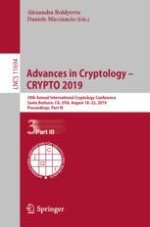The three-volume set, LNCS 11692, LNCS 11693, and LNCS 11694, constitutes the refereed proceedings of the 39th Annual International Cryptology Conference, CRYPTO 2019, held in Santa Barbara, CA, USA, in August 2019.
The 81 revised full papers presented were carefully reviewed and selected from 378 submissions. The papers are organized in the following topical sections:
Part I: Award papers; lattice-based ZK; symmetric cryptography; mathematical cryptanalysis; proofs of storage; non-malleable codes; SNARKs and blockchains; homomorphic cryptography; leakage models and key reuse.
Part II: MPC communication complexity; symmetric cryptanalysis; (post) quantum cryptography; leakage resilience; memory hard functions and privacy amplification; attribute based encryption; foundations.
Part III: Trapdoor functions; zero knowledge I; signatures and messaging; obfuscation; watermarking; secure computation; various topics; zero knowledge II; key exchange and broadcast encryption.
